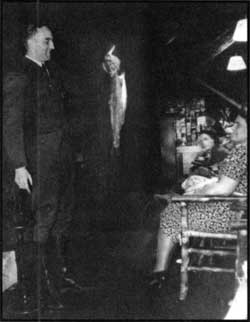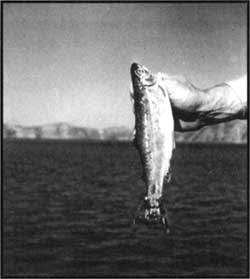Fish in Crater Lake: Their Size and Number
 Ranger-naturalist Arthur Hasler showing a rainbow trout to visitors in 1938. NPS photo. |
Anglers who routinely ‘wet a line’ in Crater Lake have learned that fishing success as well as the size of kokanee salmon and rainbow trout in the lake can fluctuate dramatically from year to year. Analysis of fish length and fish population size over the last 15 years provides insight into the patterns of change and may help anglers appreciate the ups and downs of fishing Crater Lake.
Crater Lake was naturally barren of fish until park founder William Steel first stocked Crater Lake with trout fingerlings in 1888 to “improve” recreational opportunities. Despite altering the lake’s natural condition, introductions of non-native fish continued until 1941, when stocking the lake ended. In all, five species of salmonids, totaling nearly two million fish, were introduced to the lake over the intervening 53 years. Brown trout (Salmo trutta), cutthroat trout (O. clarki),coho salmon (O. kisutch), kokanee salmon (O. nerka, a landlocked sockeye salmon), and several stocks of rainbow trout (O. mykiss) including steelhead were introduced during this period. Only the self-sustaining populations of rainbow trout and kokanee salmon persist in the lake today.
 Kokanee salmon. NPS photo by C. Warren Fairbanks, 1954. |
Detailed annual fish population estimates using high-tech acoustic systems were initiated in Crater Lake in 1996. The largest fish population observed in Crater Lake since that time occurred during the summer of 2000 when biologists estimated the total number of fish in Crater Lake at 633,000—a density of 48 fish per acre. Lake Billy Chinook near Bend, by contrast, is estimated to contain between 530 and 5500 kokanee per acre depending on the year. Coeur d’ Alene Lake in Idaho typically fluctuates around 1400 fish per acre. The lowest number of fish in Crater Lake occurred in 1998 when only 8,400 (less than 1 fish per acre) were observed. Just two years later the fish population in Crater Lake increased by an astounding 7450 percent!
The relative abundance of kokanee has been monitored with gill nets since 1986. Population size and the average length of individual kokanee salmon cycles over a period of approximately ten years (see the first two graphs in Figure 1). According to fisheries studies around the Pacific Northwest, fluctuations in kokanee population size and fish length are fairly common in unproductive bodies of fresh water such as Crater Lake. Large increases in kokanee population size that occurred in the lake during 1990-91 and 1999-2000 could therefore be expected.
Biologists studying Crater Lake believe that at low population size, food is plentiful for the kokanee and a fewer number of fish eventually reach larger size. These large and healthy adult fish reproduce successfully leading to an increase in fish numbers. As the fish population increases, the primary food of kokanee (microscopic animals in the water column called zooplankton) decreases to the point that the lake can no longer support such a high population of fish. The kokanee population size then falls through time, allowing the zooplankton population to recover so that the cycle starts over again. In water bodies other than Crater Lake, the patterns in kokanee size and number are subject to more variables such as fluctuations in water level (this is especially pronounced in reservoirs), water temperature, fish stocking density, the timing of stocking, and harvest pressure from anglers.
Rainbow trout do not feed on zooplankton like kokanee do, but instead rely mostly on aquatic insects near the lakeshore as well as those that land on the lake surface. Large rainbow trout will also eat small kokanee. The length of the largest rainbow trout caught in Crater Lake over the last 15 years has varied similarly to that of kokanee, but delayed by 1-2 years (compare the upper and lower graphs in Figure 1). Large rainbow trout were prevalent in 1991 (see Table 1) and have been increasing in number the last few years. Not surprisingly, the presence of exceptionally large rainbow trout appears to be associated with the presence of large numbers of small kokanee.
Research has shown the ecology of Crater Lake to be very dynamic and the fish population is no exception. Recent studies suggest that the quality of fishing in the lake for the foreseeable future will fluctuate depending upon the year. The extremely large increase in kokanee numbers during 1999 and 2000 will probably result in their population crashing (probably due to over exploitation of their food resources) in the next few years. This was already becoming apparent in the summer of 2000, given the dramatic increase in kokanee numbers over the previous two years.

